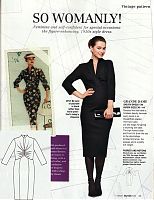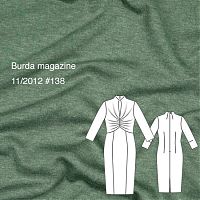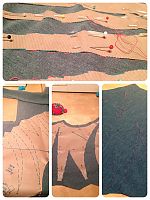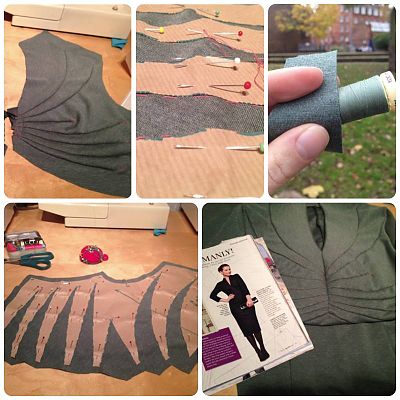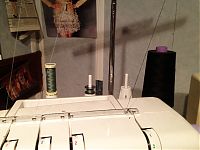My latest project is this vintage sheath dress from the November Burda magazine (which you can purchase as a pdf here if you missed the magazine)!
It’s a reprint of an original pattern Burda printed in 1956, and one of my favourite running features that Burda magazine have been doing this year. Since the company’s had a very long history, it makes sense that they should look into their archives, dust off a few gems, grade up the sizing to their usual modern range, and translate the instructions!
Contrary to popular belief, this particular one is not a maternity dress, despite the fact that the model clearly looks like she’s “showing”. I can assure you that I do not look pregnant in it one bit, so let’s move on with the catty remarks…
In any case, I finished this one on Sunday night, but considering that it gets dark at 4pm here now, I won’t be able to do a photoshoot until this weekend, meaning you won’t see it on me until next week. By which time I’ll have probably forgotten all the construction details, boo!
So by way of a reminder, I thought I’d type up my thoughts now, then you’ll see the finished design next week. So the “Tell”, then the “Show”!
1. The bodice has seven monster, curved darts, all of which needed to be accurately marked onto the fabric. If you have carbon paper, I suggest you make good use of it, but for me, I remove the inside of the darts with scissors, then thread trace each dart with silk basting thread so I can see it on both sides. Then repeat for the other bodice piece. This took a few evenings, but it was important to get them right, as it’s the focus of the entire dress!
2. Burda’s instructions have you stitch these darts closed for the first 2cm, then baste closed for the rest of the length, then press. Then if you skip to the very last step in the instructions, they say to unpick all the basting stitches, but warn that if you ever want to launder it, you need to baste them all closed again (this time without any of the thread-traced guidelines!). W-t-f? Who in the history of NEVER would ever do that?
3. I asked James and Nishi whether I should keep the darts sewn closed or open them up, and they both voted to keep them closed. So closed they’ll stay!
4. The instructions have you attach the facings in a funny way – my usual order would be to construct the entire neckline of the dress, then construct the entire neckline of the facing, and then join the two together at the neckline seam, understitch, then stitch in the ditch at the shoulders if necessary. And that’s exactly what I’d recommend doing, because Burda’s way worked, but was frankly a little nuts.
5. I didn’t use the sleeves from this pattern, instead going for my TNT Burda knit sleeve (off some pattern from 2006, though you could use Lydia or whatever you prefer). I’m fine with a 3/4 length and an elbow dart, but when I saw the sleeve cap “ease” markings I ran away, fast. Sleeve cap ease in a knit? WHY?
6. You don’t need the invisible zip. But you probably already knew that.
7. Despite making this in a knit, the construction was about 60% done on my sewing machine, with only the centre back, front skirt, side, and sleeve seams done on the overlocker (serger). There was a surprising amount of hand basting involved here, too, especially in getting those darts to line up at the centre front. So it’s by no means a quick make.
8. I shortened the hem by 13cm, and removed the back skirt vent, because there was hardly any left of it after the shortening. I shortened it mostly because I thought I’d bought 2m of sage green pontiroma from Truro Fabrics but it was actually only 1.5m, and shortening the skirt pieces meant I should still fit it all in.
9. I totally freaking love the colour and fit of this dress. LOVE.
10. I bought a matching spool of Gutermann thread, and that enabled me to do all the sewing machine stitches in a stealth colour. For the overlocked seams I just used black, but then when it came time to do the hems, I didn’t have any suitable sage green thread cones (grey was the closest, but not great). So I used my favourite thrifty trick and used the sewing machine thread and bobbin in the needles of my coverstitch (the underside doesn’t really matter, so I kept the black spool on there).
Hooray, nice, matching hems! You could do something similar if you use a twin needle on your sewing machine for your hems – just move the matching thread bobbin up to the second spool position on the top of your machine, and place a different coloured bobbin in the bobbin holder. It’s the same effect – matching thread on the “good” side, and unmatching thread on the wrong side.
I may sound a bit overly grumpy here, but don’t get me wrong – I love, love, love the finished dress! I can tell already it’s going to be a favourite in my winter wardrobe. I just wouldn’t want a beginner to stumble into it thinking it’s going to be easy, or indicative of other Burda magazine patterns.

